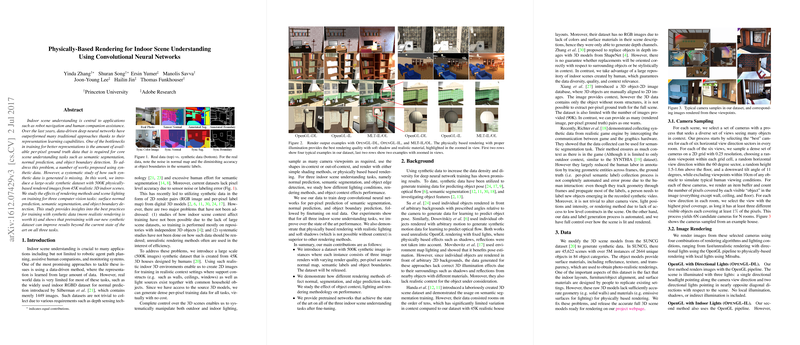Physically-Based Rendering for Indoor Scene Understanding Using Convolutional Neural Networks
The presented paper explores the enhancement of indoor scene understanding through the utilization of physically-based rendering (PBR) techniques and synthetic data within convolutional neural networks (CNNs). Indoor scene understanding holds significant relevance across various domains such as robotics and human-computer interaction, yet it is hampered by the paucity of high-quality training data. This paper addresses the scarcity of real-world, per-pixel ground truth data essential for training deep neural networks in tasks like semantic segmentation, surface normal prediction, and object boundary detection.
Synthetic Data and Physically-Based Rendering
The authors introduce a synthetic dataset comprising 500,000 images, rendered from 45,000 realistic 3D indoor scenes. These images simulate training data at a large scale, which is pivotal given the constrained available indoor datasets, such as the NYUv2 dataset with only 1,449 images. Previous implementations have demonstrated the utility of synthetic data in boosting neural network training, yet a comprehensive examination regarding the impact of rendering methods on learning outcomes remains sparse. The authors systematically investigate the implications of various rendering techniques—OpenGL-DL, OpenGL-IL, and MLT-IL/OL—on CNN performance.
Methodological Advances
The methodological innovation lies in leveraging MIT's Mitsuba renderer to generate images through Metropolis Light Transport (MLT) algorithms, which simulate realistic light behaviors, providing soft shadows and accurate material portrayals. These images, coupled with annotated ground truths for training machine learning models, are expected to enhance the performance of three quintessential computer vision tasks: normal prediction, semantic segmentation, and object edge detection. Importantly, the authors demonstrate that pretraining CNNs with images rendered using their PBR method confers superior outcomes compared to existing practices reliant on traditional rendering techniques.
Experimental Results and Analysis
Across the evaluated tasks, pretraining on this new synthetic dataset consistently elevates performance metrics beyond the current state-of-the-art benchmarks:
- Normal Estimation: Models pretrained on PBR-derived images outperform those using OpenGL-rendered data in predicting accurate surface normals, corroborated by a decrease in angular error metrics.
- Semantic Segmentation: The large-scale and varied dataset aids in capturing high-level context, as seen in the improved intersection-over-union (IoU) scores compared to models trained with limited real data or depth information alone.
- Object Boundary Detection: The propensity of PBR to deliver photo-realistic edge details is evident, with models exhibiting enhanced detection precision, particularly in discriminating true object boundaries against background interferences.
These robust numerical results substantiate the claim that realistic synthetic image data is instrumental in advancing the fidelity of indoor scene understanding models.
Implications and Future Directions
The implications of this research extend both practically and theoretically. Practically, by circumventing the arduous task of collecting and annotating extensive real-world image datasets, researchers can capitalize on scalable and rich synthetic datasets for training deep learning models, thereby streamlining developments in autonomous systems and other AI applications. Theoretically, these results catalyze further explorations into optimizing synthetic data generation and utilization, potentially incorporating advancements like conditional generative adversarial networks (cGANs) for enhanced realism.
Future endeavors could investigate domain adaptation techniques to ameliorate the domain gap between synthetic and real scenes and explore adaptive learning methodologies to leverage the increasing diversity of synthetic datasets effectively. Furthermore, as the dataset will be made accessible, it provides a fertile ground for other researchers to extend the scope and applicability of indoor scene understanding algorithms.
In summary, the work substantiates the efficacy of physically-based renderings in synthetic datasets to bolster indoor scene understanding, marking a notable stride in employing photo-realistic data generation to refine machine learning applications in computer vision.
